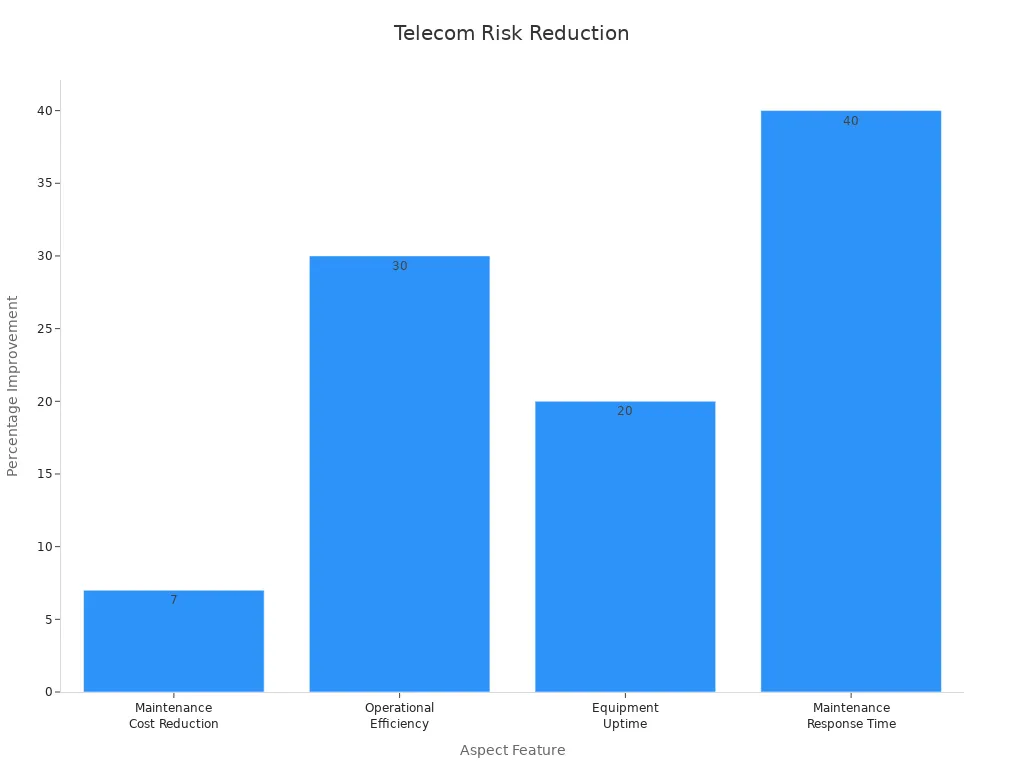Why rack mount rectifier is safer for telecom equipment

You gain superior safety for your telecom equipment when you use a rack mount rectifier. This solution minimizes downtime, improves operational efficiency, and delivers stable power output, which protects your sensitive systems from unexpected failures. You address risks by choosing a system that offers faster maintenance response, lower operational costs, and higher equipment uptime.
Aspect / Feature | Evidence / Impact |
|---|---|
Maintenance Cost Reduction | Reduced to about 7% of traditional systems, lowering operational risks. |
Operational Efficiency | Improved by 30%. |
Equipment Uptime | Increased by 20%. |
Maintenance Response Time | 40% faster. |
Power Quality | Consistent DC output, high power factor, and low distortion. |
Reliability Compared to UPS | Over 20 times more reliable. |
Backup and Redundancy | Modular design ensures continuous supply. |

You ensure compliance with industry standards while reducing the likelihood of service interruptions and costly emergency repairs.
Key Takeaways
Rack mount rectifiers improve telecom safety by providing stable power, reducing downtime, and enabling faster maintenance.
Secure mounting and organized cable management prevent physical hazards and service interruptions, keeping equipment and personnel safe.
Modular design allows quick replacement of faulty parts without shutting down the system, minimizing outages and repair time.
Advanced grounding, protection circuits, and stable DC output protect equipment from electrical faults and power disturbances.
Built-in redundancy and battery management ensure continuous power supply, enhancing reliability and meeting industry safety standards.
Rack Mount Rectifier Safety
Secure Mounting
You ensure a safer telecom environment when you choose a rack mount rectifier that fits standard 19-inch or 23-inch racks. This secure installation method reduces the risk of equipment movement, accidental disconnection, and physical hazards. You avoid instability and tipping by distributing weight evenly and using manufacturer-recommended hardware. Tamper-proof screws and locks prevent unauthorized access, while regular inspections help you catch any loosening or damage early.
Tip: Securely mounting cables overhead or through walls, instead of letting them run across floors, significantly lowers trip hazards and keeps your workspace compliant with safety standards.
Installation Best Practices for Secure Mounting:
Use proper rack screws and cage nuts to firmly attach equipment.
Evaluate load capacity to prevent overloading.
Employ tamper-proof hardware for added security.
Inspect mounting points regularly for signs of wear or loosening.
Organize cables to avoid tangling and accidental disconnections.
You create a safer, more reliable telecom setup by following these practices. Secure mounting not only protects your equipment but also safeguards personnel working around the racks.
Cable Management
You reduce operational risks and improve system reliability when you implement advanced cable management with your rack mount rectifier. Poor cable organization can increase troubleshooting time by up to 60%, leading to longer outages and higher maintenance costs. When you plan cable routes, label cables, and use structured cabling systems, you make it easier to trace connections and resolve issues quickly.
Effective cable management extends cable lifespan by 50% and increases network equipment life expectancy by over 30%.
Organized cables improve airflow, which enhances cooling efficiency and reduces energy costs.
Companies that enforce strict cable management report fewer network outages and lower downtime.
Note: Vertical cable management and ZeroU systems free up valuable rack and floor space, supporting future growth and scalability.
You also benefit from improved safety. Organized cables prevent tripping hazards and accidental unplugging, which can cause unexpected service interruptions. Regular audits and removal of unused devices keep your racks tidy and efficient. By prioritizing cable management, you create a safer and more productive telecom environment.
Modular Design
You gain significant safety advantages when you use a rack mount rectifier with a modular design. Modular systems allow you to isolate and replace faulty modules quickly, reducing mean time to repair (MTTR) by up to 50%. This approach minimizes downtime and ensures your telecom equipment remains operational even during maintenance.
Modular design breaks complex systems into smaller, manageable units, making repairs less complicated.
You can identify and address faults at the module level, which simplifies troubleshooting and reduces the risk of human error.
Hot-swappable modules let you perform maintenance without shutting down the entire system, keeping your network running smoothly.
A real-world case study showed a 40% reduction in MTTR for power electronics systems using modular design and advanced fault detection. You benefit from simplified fault diagnosis, faster repairs, and improved maintainability—all of which contribute to a safer telecom environment.
Technical Feature | Safety Advantage / Validation |
|---|---|
Advanced semiconductor materials (SiC, GaN) | Improve efficiency and reduce heat generation, lowering electrical stress and risk of thermal damage. |
Soft-switching technology | Reduces energy losses and electrical noise, enhancing operational safety and equipment longevity. |
Modular design with built-in protections | Overvoltage, overcurrent, and thermal safeguards protect equipment and personnel from electrical faults. |
Galvanic isolation via DC-DC converters | Prevents electrical interference and protects sensitive telecom equipment from voltage spikes and short circuits. |
Intelligent controllers and remote monitoring | Enable real-time fault detection, predictive maintenance, and automated shutdowns, reducing risk of failures. |
Battery backup with advanced protections | Temperature monitoring and fault detection ensure safe operation during power outages, protecting equipment. |
Enclosures designed for safety | Prevent accidental contact and contain hazards, protecting personnel. |
High efficiency and power factor correction | Reduce electrical disturbances and heat, improving overall system safety. |
N+1 redundancy configuration | Ensures continuous power supply, minimizing outage risks that could compromise safety. |
You see that a rack mount rectifier with modular design and advanced safety features not only streamlines maintenance but also protects your telecom infrastructure from a wide range of risks. This approach keeps your network stable, efficient, and secure.
Electrical Protection

Grounding and Isolation
You achieve a safer telecom environment when you use rack mount rectifiers with advanced grounding and isolation features. These systems provide galvanic isolation from the utility grid, which significantly reduces electrical disturbances such as transients and harmonics. You benefit from:
Galvanic isolation that shields your sensitive equipment from power-line disturbances.
Large system batteries that act as filters, almost eliminating the risk of voltage spikes reaching your telecom devices.
Simpler and more uniform grounding practices compared to AC UPS systems, which lowers safety hazards and makes maintenance easier.
Higher availability rates—studies show DC systems with rack mount rectifiers are over 20 times more reliable than comparable AC UPS setups.
Fewer battery cells in series, which means lower fault frequency and fewer incidents that could affect your service.
No need for oversizing or extra harmonic filters, reducing both cost and failure rates.
Uniform grounding standards that simplify installation and improve fault analysis.
Tip: Consistent grounding and isolation practices not only protect your equipment but also make troubleshooting and maintenance safer and faster.
Protection Circuits
You reduce electrical hazards by relying on the robust protection circuits built into rack mount rectifiers. These circuits address DC-specific risks and ensure your telecom equipment stays protected. Key reasons include:
Compliance with NFPA 70E standards, which enhances workplace electrical safety.
Use of circuit breakers and fault-current limiting devices that prevent overloads and short circuits.
Implementation of lockout/tagout (LOTO) procedures, ensuring equipment is de-energized before maintenance.
Thorough risk assessments that help you identify and address potential electrical hazards.
Ongoing training and awareness programs that keep your team informed about proper safety measures.
Protection strategies tailored for DC hazards, including battery systems and DC converters.
You create a safer work environment and reduce the risk of costly electrical incidents by prioritizing these protection measures.
Stable DC Output
You ensure long-term reliability for your telecom network when you choose rack mount rectifiers that deliver stable DC output. Real-world data from telecom operators shows that these rectifiers maintain consistent voltage regulation, even under changing input conditions. For example, GreenConnect deployed rectifiers across 500 remote sites and saw a 25% reduction in downtime, thanks to stable voltage and reliable performance.
DC power systems eliminate voltage fluctuations and harmonics, which often disrupt sensitive telecom equipment. You benefit from low ripple voltage, strong load regulation, and excellent line regulation. These features keep your network running smoothly, reduce maintenance needs, and protect your investment over time.
Consistent DC output is essential for telecom reliability. You avoid unexpected outages and keep your systems operating at peak efficiency by choosing rack mount rectifiers with proven stability.
Operational Reliability
Redundancy
You achieve higher operational reliability in your telecom systems when you use rack mount rectifiers with built-in redundancy. Redundant components, such as power supplies and network modules, allow your system to continue running even if one part fails. This seamless failover prevents service interruptions and protects your critical data.
Redundant power supplies ensure uninterrupted power to essential equipment.
Hot standby systems provide immediate backup, reducing downtime.
Geographic and physical redundancy, like multiple data centers or diverse fiber routes, protect your network from localized failures.
Regular testing and real-time monitoring of redundant hardware verify system health and failover readiness.
Tip: Redundancy measures help you meet strict service level agreements by minimizing downtime and enhancing reliability.
Battery Management
You maintain continuous operation and protect your telecom infrastructure by using advanced battery management systems (BMS) in your rack mount rectifiers. These systems actively monitor battery health, regulate voltage, and provide predictive maintenance alerts. You avoid unexpected failures and extend equipment lifespan by leveraging real-time data and proactive management.
Advanced BMS prevents overcharging, over-discharging, and overheating.
Predictive maintenance and IoT integration enable early detection of battery issues.
Routine inspections and timely battery replacements keep backup power reliable.
Modular and scalable battery designs adapt to growing network demands without service disruption.
Integration with renewable energy sources ensures reliable power in remote or off-grid locations.
Industry benchmarks highlight BMS as essential for safe operation, consistent power delivery, and resilience in harsh environments.
Cooling
You reduce the risk of equipment failure and service disruption by ensuring efficient cooling in your rack mount rectifier setup. Modern telecom environments generate significant heat, especially under high demand. Efficient cooling systems maintain optimal operating temperatures, supporting business continuity and system reliability.
Modular cooling solutions allow you to scale infrastructure without costly downtime.
Robust cooling maintains performance and prevents thermal damage.
Efficient cooling reduces operational costs, as cooling can account for up to 55% of energy use in telecom facilities.
Empirical research confirms that advanced cooling technologies, such as direct-to-chip and hybrid cooling, improve energy efficiency and support high power densities. You ensure your telecom equipment operates safely and efficiently, even as network demands grow.
Compliance and Standards
Industry Requirements
You need to meet strict industry requirements when deploying telecom power systems. A rack mount rectifier helps you achieve compliance with recognized safety standards and regulations. Certification bodies use conformity assessment activities such as testing, inspection, and auditing to verify that your equipment meets these standards. You can quickly identify compliant products by looking for certification marks like UL, CSA, ETL, or ANCE. These marks show that your rectifier has passed rigorous safety checks and meets North American electrical codes. The IECEE CB Scheme also allows you to use one set of test results for international acceptance, making global deployments easier.
Aspect | Details |
|---|---|
Conformity Assessment Definition | Activities such as testing, inspection, auditing, certification to verify compliance with standards |
Relevant Standards for Certification Bodies | ANSI/ASTM E 1906-99, ISO/IEC Guide 65:1996, ANSI/ASTM 1904-99, ISO/IEC Guide 22:1996 |
Certification Marks Indicating Compliance | UL, CSA, ETL, ANCE (for North American standards) |
CE Mark | Indicates compliance with EU requirements only; not sufficient for North American electrical code compliance |
IECEE CB Scheme | Facilitates international acceptance of product safety test results, enabling 'one Standard, one test, accepted everywhere' |
NEMA Role | Develops standards but does not certify products |
You reduce risk and avoid costly penalties by choosing certified rack mount rectifiers. Certification ensures your equipment meets the latest safety requirements and passes regular audits.
Consistent Performance
You want your telecom equipment to deliver reliable performance every day. Integrated AC/DC distribution in rack mount rectifiers assures you of consistent power delivery across all installations. Performance benchmarks show that DC distribution systems with optimized converter topologies achieve higher efficiency and lower power losses than traditional AC systems. For example, you can save up to 0.2 million USD in energy costs and reduce power loss by 500 KW with a well-designed DC system. These improvements mean your network runs more efficiently and reliably.
You also benefit from a robust certification process that verifies consistent performance:
You start with an initial application and product review.
Audits and inspections confirm your equipment meets all requirements.
Routine testing checks that your rectifier maintains certified performance.
Recertification follows any major design changes or updates to standards.
Safety protocols, including PPE, lockout/tagout, and risk assessments, keep your equipment safe and reliable.
Regular audits and ongoing testing ensure your rack mount rectifier continues to meet evolving industry standards, giving you peace of mind and long-term reliability.
You achieve superior telecom safety when you choose a rack mount rectifier. Modularity, redundancy, and compliance work together to reduce risks and ensure reliable operation. The BlueAlly and Vertiv case studies show that modular designs and parallel systems prevent outages, even during disasters or equipment failures. You protect your network from cascading failures and maintain uptime through regular audits and operational controls. Prioritize rack mount rectifiers to safeguard your telecom infrastructure and deliver consistent, uninterrupted service.
FAQ
Why does a rack mount rectifier reduce the risk of equipment failure?
You lower the risk of equipment failure because rack mount rectifiers provide stable power and advanced protection circuits. These features prevent voltage spikes and overheating, which often cause outages in telecom systems.
Tip: Consistent power delivery keeps your network running smoothly.
Why should you choose a modular rack mount rectifier for telecom safety?
You benefit from modular rack mount rectifiers because you can replace faulty modules without shutting down your system. This design reduces downtime and minimizes the risk of service interruptions.
Hot-swappable modules
Faster repairs
Why is cable management better with rack mount rectifiers?
You achieve better cable management because rack mount rectifiers organize cables within the rack. This setup prevents tangling and accidental disconnections, which can lead to outages or safety hazards.
Benefit | Impact |
|---|---|
Organized cables | Fewer outages |
Clear labeling | Faster troubleshooting |
Why do rack mount rectifiers help you meet industry safety standards?
You meet industry safety standards because rack mount rectifiers come with certifications like UL or CE. These certifications prove that your equipment passes strict safety tests and complies with telecom regulations.
Certified equipment protects your investment and reputation.
Why does redundancy in rack mount rectifiers improve telecom reliability?
You improve reliability because redundant rack mount rectifiers provide backup power. If one module fails, another takes over instantly. This setup prevents downtime and protects your critical telecom services.
See Also
Steps To Guarantee Consistent Power For Telecom Cabinets
Understanding The Use Of -48VDC And Grounding In Telecom Cabinets
Advantages Of Lithium Batteries Over Others In Telecom Cabinets
Effective Ways To Safeguard Equipment Using Outdoor Telecom Cabinets
Guide To Choosing And Installing Pole-Mounted Telecom Cabinets Safely
CALL US DIRECTLY
86-13752765943
3A-8, SHUIWAN 1979 SQUARE (PHASE II), NO.111, TAIZI ROAD,SHUIWAN COMMUNITY, ZHAOSHANG STREET, NANSHAN DISTRICT, SHENZHEN, GUANGDONG, CHINA
